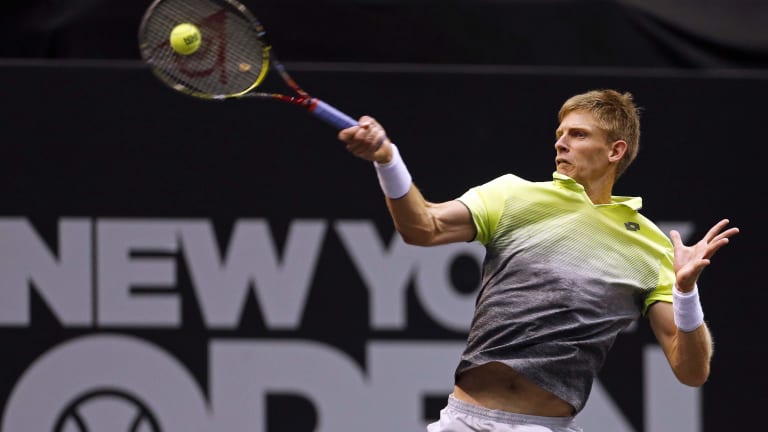While Roger Federer drew most of the headlines this past weekend for securing the 97th title of his illustrious career in Rotterdam, another admirable individual was busy winning his first tournament since Winston Salem in the summer of 2015. Out on Long Island at the New York Open, the industrious Kevin Anderson claimed his fourth career ATP tour title by overcoming Sam Querrey in a first-rate final fought out indoors on a black hard court in front of an appreciative audience.
Anderson, of course, celebrated a career milestone last September not far away at the U.S. Open, reaching his first major final before bowing out against a finely tuned Rafael Nadal. But his record since that sparkling run at Flushing Meadows has been lackluster. He played five tournaments in 2017 after the Open, and came away with very little. His match record in that span was 3-5, and tiebreakers were often his downfall.
The 6’8” South African was ousted in a final set tiebreaker by Ryan Harrison in the round of 16 at Tokyo, fell in a pair of tiebreaks against Jan-Lennard Struff in the second round of Shanghai, and suffered the same fate against Spain’s left-handed Fernando Verdsasco in the quarters of Stockholm—dropping two more tiebreakers there. Thereafter, Anderson lost in the first round of Vienna to Guillermo Garcia-Lopez, and then was beaten in his opening-round assignment against Verdasco indoors at Paris.
That was surely not the way Anderson wanted to conclude his 2017 season. He faded down the stretch after his inspired journey at the U.S. Open. Making amends, he got to the final of his first tournament of 2018 in Pune, India, but was beaten somewhat surprisingly by the human backboard, Giles Simon. On he went to Melbourne for the Australian Open with good preparation and much encouragement, but Anderson was halted in a five-set, first-round meeting against the decidedly improved Kyle Edmund.
And so the big man came last week to Long Island determined to bring out his best tennis, hoping to ignite his game and impose his will. He was thoroughly tested every time he stepped out on the court at the New York Open, but Anderson met those moments with unwavering determination and remarkable composure. He commenced his campaign with a 3-6, 6-4, 7-6 (5) triumph over Ernesto Escobedo, followed by fending off the spirited Frances Tiafoe 6-3, 5-7, 6-4, and then withstood a fierce comeback from Kei Nishikori in the penultimate round. Anderson prevailed in that one, 6-1, 3-6, 7-6 (4).
Anderson versus Querrey always figured to be a close and intriguing confrontation, and that is precisely what it turned out to be. They had faced each other 15 times in head-to-head competition, with Querrey leading 8-7 in the series. Last year, Querrey edged Anderson in five sets in a round of 16 collision at Wimbledon, but Anderson was victorious over the 6’6” American in a riveting four-set showdown under the lights in the U.S. Open quarterfinals.
Having watched that skirmish at the Open, I relished the opportunity to see them go at it again a few days ago. These two players are so evenly matched that their clashes are almost invariably suspenseful, hard fought, and highly charged. Both men move extraordinarily well for their size. Their wingspan makes them dangerous on returns. Anderson’s backhand down the line is much improved; Querrey’s forehand down the line is among the best in tennis. They are two of the premier servers in tennis.
